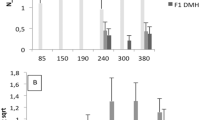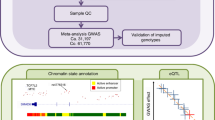Abstract
Treatment of mice with the carcinogen azoxymethane (AOM) induces a number of lesions in the colon, including hyperplastic lesions, as well adenomas and carcinomas in situ. Inbred strains of mice show different responses to AOM-induced carcinogenesis. A/J mice are highly susceptible and develop a greater number of hyperplastic lesions and tumors (15–70 tumors per mouse) than resistant C57BL/6J mice (0–6 tumors per mouse). Susceptibility to AOM-induced tumors segregates as a co-dominant trait in (A × B6)F1 hybrids. Using a set of 23 AcB and BcA recombinant congenic mouse strains derived from A/J (susceptible) and B6 (resistant) parents, we observed that the number of hyperplastic lesions and tumors induced by AOM was under different genetic controls in AcB/BcA strains. The multiplicity of AOM-induced tumors is controlled by a major locus that we have mapped on the distal portion of chromosome 3, to which we have given the temporary designation colon cancer susceptibility locus 3 (Ccs3). B6 and A/J alleles at Ccs3 are associated with resistance and susceptibility, respectively. Haplotype analysis in key informative AcB/BcA strains restricts the size of the Ccs3 locus to a 14 Mb segment that contains 94 annotated genes. The expression level of all these genes in normal colon has been established by transcript profiling with microarrays, and has led to the identification of a subset of positional candidates that are expressed at high levels in this tissue. The 4q and 1p human chromosomal segments sharing syntenic homology with the mouse Ccs3 segment are known to be associated with inflammatory bowel diseases and colorectal tumors in humans, suggesting that the study of the mouse Ccs3 locus may help further the pathogenesis of these human conditions.
This is a preview of subscription content, access via your institution
Access options
Subscribe to this journal
Receive 50 print issues and online access
$259.00 per year
only $5.18 per issue
Buy this article
- Purchase on Springer Link
- Instant access to full article PDF
Prices may be subject to local taxes which are calculated during checkout








Similar content being viewed by others
References
Akagi K, Suzuki T, Stephens RM, Jenkins NA, Copeland NG . (2004). RTCGD: retroviral tagged cancer gene database. Nucleic Acids Res 32: D253–D527.
Angel JM, Popova N, Lanko N, Turusov VS, DiGiovanni J . (2000). A locus that influences susceptibility to 1,2-dimethylhydrazine-induced colon tumors maps to the distal end of mouse chromosome 3. Mol Carcinog 27: 47–54.
Barrett JC, Hansoul S, Nicolae DL, Cho JH, Duerr RH, Rioux JD et al. (2008). Genome-wide association defines more than 30 distinct susceptibility loci for Crohn's disease. Nat Genet 40: 955–962.
Cho JH, Nicolae DL, Gold LH, Fields CT, LaBuda MC, Rohal PM et al. (1998). Identification of novel susceptibility loci for inflammatory bowel disease on chromosomes 1p, 3q, and 4q: evidence for epistasis between 1p and IBD1. Proc Natl Acad Sci USA 95: 7502–7507.
Cianciulli A, Cosimelli M, Marzano R, Merola R, Piperno G, Sperduti I et al. (2004). Genetic and pathologic significance of 1p, 17p, and 18q aneusomy and the ERBB2 gene in colorectal cancer and related normal colonic mucosa. Cancer Genet Cytogenet 151: 52–59.
Couturier-Turpin MH, Bertrand V, Couturier D . (2001). Distal deletion of 1p in colorectal tumors: an initial event and/or a step in carcinogenesis? Study by fluorescence in situ hybridization interphase cytogenetics. Cancer Genet Cytogenet 124: 47–55.
de la Chapelle A . (2004). Genetic predisposition to colorectal cancer. Nat Rev Cancer 4: 769–780.
Demant P . (2003). Cancer susceptibility in the mouse: genetics, biology and implications for human cancer. Nat Rev Genet 49: 721–734.
Deschner EE, Long FC, Hakissian M . (1988). Susceptibility to 1,2-dimethylhydrazine-induced colonic tumors and epithelial cell proliferation characteristics of F1, F2, and reciprocal backcrosses derived from SWR/J and AKR/J parental mouse strains. Cancer Causes Control 61: 478–482.
Dragani TA . (2003). 10 years of mouse cancer modifier loci: human relevance. Cancer Res 63: 3011–3018.
Evans JT, Shows TB, Sproul EE, Paolini NS, Mittelman A, Hauschka S . (1977). Genetics of colon carcinogenesis in mice treated with 1,2-dimethylhydrazine. Cancer Res 37: 134–136.
Fijneman RJ, Demant P . (1995). A gene for susceptibility to small intestinal cancer, Ssic1, maps to the distal part of mouse chromosome 4. Cancer Res 55: 3179–3182.
Fortin A, Diez E, Henderson JE, Mogil JS, Gros P, Skamene E . (2007). The AcB/BcA recombinant congenic strains of mice: strategies for phenotype dissection, mapping and cloning of quantitative trait genes. Novartis Found Symp 281: 141–153.
Fortin A, Diez E, Rochefort D, Laroche L, Malo D, Rouleau GA et al. (2001). Recombinant congenic strains derived from A/J and C57BL/6J: a tool for the genetic dissection of complex traits. Genomics 74: 21–35.
Greten FR, Eckmann L, Greten TF, Park JM, Li ZW, Egan LG et al. (2004). IKKβ links inflammation and tumorigenesis in a mouse model of colitis-associated cancer. Cell 118: 285–296.
Gross OG, Grupp C, Steinberg C, Zimmermann S, Strasser D, Hannesschläger N et al. (2008). Multiple ITAM-coupled NK-cell receptors engage the Bcl10/Malt1 complex via Carma1 for NF-{kappa}B and MAPK activation to selectively control cytokine production. Blood 112: 2421–2428.
Herath NI, Leggett BA, MacDonald GA . (2006). Review of genetic and epigenetic alterations in hepatocarcinogenesis. J Gastroenterol Hepatol 21: 15–21.
Jacoby RF, Hohman C, Marshall DJ, Frick TJ, Schlack S, Broda M et al. (1994). Genetic analysis of colon cancer susceptibility in mice. Genomics 22: 381–387.
Jaeger E, Webb E, Howarth K, Carvajal-Carmona L, Rowan A, Broderick P et al. (2008). Common genetic variants at the CRAC1 (HMPS) locus on chromosome 15q13.3 influence colorectal cancer risk. Nat Genet 40: 26–28.
Karin M . (2008). The IkappaB kinase—a bridge between inflammation and cancer. Cell Res 18: 334–342.
Kurashina K, Yamashita Y, Ueno T, Koinuma K, Ohashi J, Horie H et al. (2008). Chromosome copy number analysis in screening for prognosis-related genomic regions in colorectal carcinoma. Cancer Sci 99: 1835–1840.
Lothe RA, Andersen SN, Hofstad B, Meling GI, Peltomäki P, Heim S et al. (1995). Deletion of 1p loci and microsatellite instability in colorectal polyps. Genes Chrom Cancer 14: 182–188.
Malo D, Vogan K, Vidal S, Hu J, Cellier M, Schurr E et al. (1994). Haplotype mapping and sequence analysis of the mouse Nramp gene predict susceptibility to infection with intracellular parasites. Genomics 23: 51–61.
Manly KF, Cudmore Jr RH, Meer JM . (2001). Map Manager QTX, cross-platform software for genetic mapping. Mamm Genome 12: 930–932.
Min-Oo G, Fortin A, Pitari G, Tam M, Stevenson MM, Gros P . (2007). Complex genetic control of susceptibility to malaria: positional cloning of the Char9 locus. J Exp Med 204: 511–524.
Min-Oo G, Fortin A, Tam MF, Nantel A, Stevenson MM, Gros P . (2003). Pyruvate kinase deficiency in mice protects against malaria. Nat Genet 35: 357–362.
Moen CJA, Groot PC, Hart AAM, Snoek M, Demant P . (1996). Fine mapping of colon tumor susceptibility (Scc) genes in the mouse, different from the genes known to be somatically mutated in colon cancer. Proc Natl Acad Sci USA 93: 1082–1086.
Nambiar PR, Girnun G, Lillo NA, Guda K, Whiteley HE, Rosenberg DW . (2003). Preliminary analysis of azoxymethane induced colon tumors in inbred mice commonly used as transgenic/knockout progenitors. Int J Oncol 22: 145–150.
Nancarrow DJ, Handoko HY, Smithers BM, Gotley DC, Drew PA, Watson DI et al. (2008). Genome-wide copy number analysis in esophageal adenocarcinoma using high-density single-nucleotide polymorphism arrays. Cancer Res 68: 4163–4172.
Pacifico F, Leonardi A . (2006). NF-kappaB in solid tumors. Biochem Pharmacol 72: 1142–1152.
Papanikolaou A, Wang Q-S, Delker DA, Rosenberg DW . (1998). Azoxymethane-induced tumors and aberrant crypt foci in mice of different genetic susceptibility. Cancer Lett 130: 29–34.
Rajagopalan H, Nowak MA, Vogelstein B, Lengauer C . (2003). The significance of unstable chromosomes in colorectal cancer. Nat Rev Cancer 3: 695–701.
Ruivenkamp C, Hermsen M, Postma C, Klous A, Baak J, Meijer G et al. (2003). LOH of PTPRJ occurs early in colorectal cancer and is associated with chromosomal loss of 18q12-21. Oncogene 22: 3472–3473.
Shih IM, Zhou W, Goodman SN, Lengauer C, Kinzler KW, Vogelstein B . (2001). Evidence that genetic instability occurs at an early stage of colorectal tumorigenesis. Cancer Res 61: 818–822.
Stork PJ . (2003). Does Rap1 deserve a bad Rap? Trends Biochem Sci 28: 267–275.
Stork PJ, Dillon TJ . (2005). Multiple roles of Rap1 in hematopoietic cells: complementary versus antagonistic functions. Blood 106: 2952–2961.
Study C . (2008). Meta-analysis of genome-wide association data identifies four new susceptibility loci for colorectal cancer. Nat Gen 40: 1426–1435.
Suzui M, Okuno M, Tanaka T, Nakagama H, Moriwaki H . (2002). Enhanced colon carcinogenesis induced by azoxymethane in min mice occurs via a mechanism independent of beta-catenin mutation. Cancer Lett 183: 31–41.
Takahashi M, Wakabayashi K . (2004). Gene mutations and altered gene expression in azoxymethane-induced colon carcinogenesis in rodents. Cancer Sci 95: 475–480.
Tenesa A, Farrington SM, Prendergast JG, Porteous ME, Walker M, Haq N et al. (2008). Genome-wide association scan identifies a colorectal cancer susceptibility locus on 11q23 and replicates risk loci at 8q24 and 18q21. Nat Genet 40: 631–637.
Thome M . (2004). CARMA1, BCL-10 and MALT1 in lymphocyte development and activation. Nat Rev Immunol 4: 348–350.
Tomlinson I, Webb E, Carvajal-Carmona L, Broderick P, Kemp Z, Spain S et al. (2007). A genome-wide association scan of tag SNPs identifies a susceptibility variant for colorectal cancer at 8q24.21. Nat Gen 39: 984–988.
Tomlinson IP, Webb E, Carvajal-Carmona L, Broderick P, Howarth K, Pittman AM et al. (2008). A genome-wide association study identifies colorectal cancer susceptibility loci on chromosomes 10p14 and 8q23.3. Nat Genet 40: 623–630.
Tuite A, Elias M, Picard S, Mullick A, Gros P . (2005). Genetic control of susceptibility to Candida albicans in susceptible A/J and resistant C57BL/6J mice. Genes Immun 6: 672–682.
Van Wezel T, Stassen AP, Moen CJ, Hart AA, van der Valk MA, Demant P . (1996). Gene interaction and single gene effects in colon tumour susceptibility in mice. Nat Genet 14: 468–470.
Willis TG, Jadayel DM, Du MQ, Peng H, Perry AR, Abdul-Rauf M et al. (1999). Bcl10 is involved in t(1;14)(p22;q32) of MALT B cell lymphoma and mutated in multiple tumor types. Cell 96: 35–45.
Wood LD, Parsons DW, Jones S, Lin J, Sjöblom T, Leary RJ et al. (2007). The genomic landscapes of human breast and colorectal cancers. Science 318: 1108–1113.
Xue L, Morris SW, Orihuela C, Tuomanen E, Cui X, Wen R et al. (2003). Defective development and function of Bcl10-deficient follicular, marginal zone and B1 B cells. Nat Immunol 4: 857–865.
Zanke BW, Greenwood CM, Rangrej J, Kustra R, Tenesa A, Farrington SM et al. (2007). Genome-wide association scan identifies a colorectal cancer susceptibility locus on chromosome 8q24. Nat Genet 39: 989–994.
Acknowledgements
We thank George Chountalos for his work in the haplotype mapping of the genetic interval of Ccs3 in common mouse strains. This work was supported by research grants to PG and NB from the National Cancer Institute of Canada and the Canderel Initiative Program of the Goodman Cancer Centre. PG is a James McGill professor of biochemistry.
Author information
Authors and Affiliations
Corresponding author
Additional information
Supplementary Information accompanies the paper on the Oncogene website (http://www.nature.com/onc)
Supplementary information
Rights and permissions
About this article
Cite this article
Meunier, C., Cai, J., Fortin, A. et al. Characterization of a major colon cancer susceptibility locus (Ccs3) on mouse chromosome 3. Oncogene 29, 647–661 (2010). https://doi.org/10.1038/onc.2009.369
Received:
Revised:
Accepted:
Published:
Issue Date:
DOI: https://doi.org/10.1038/onc.2009.369



